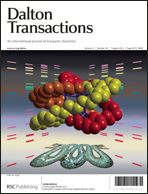Stabilization of cyclic and acyclic carbon(0) compounds by differential coordination of heterocyclic carbenes: a theoretical assessment†
Abstract
Recently, donor stabilized divalent carbon(0) compounds have undergone intense experimental and theoretical investigation due to their strong electron rich character. In this Article, some new cyclic and acyclic carbon(0) compounds stabilized by differential coordination modes (such as abnormal, remote and a mixture of both) of


 Please wait while we load your content...
Please wait while we load your content...